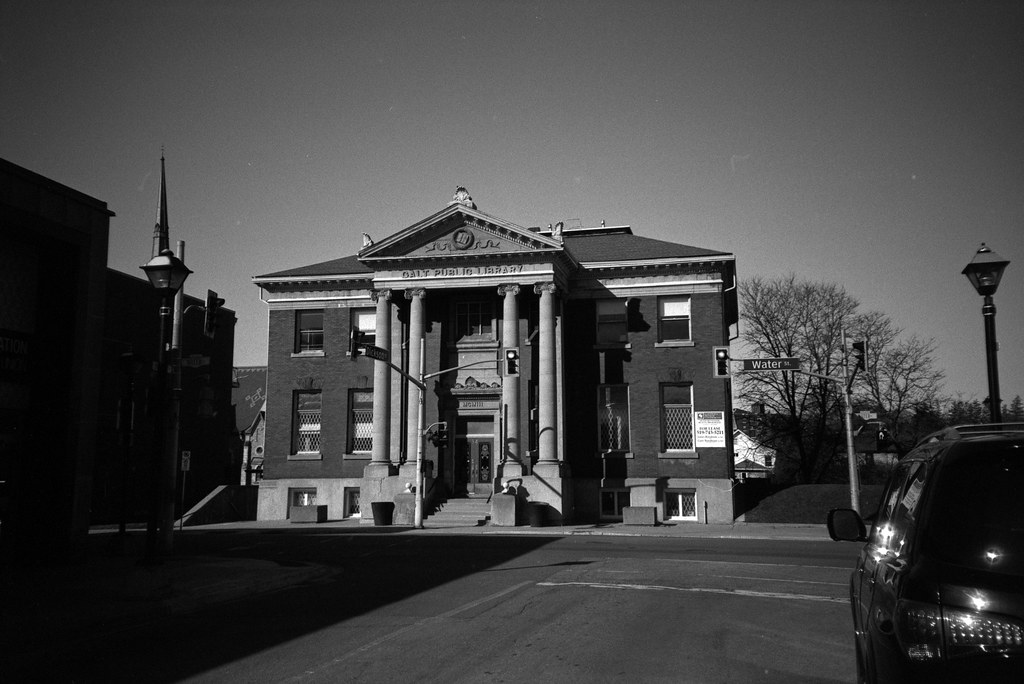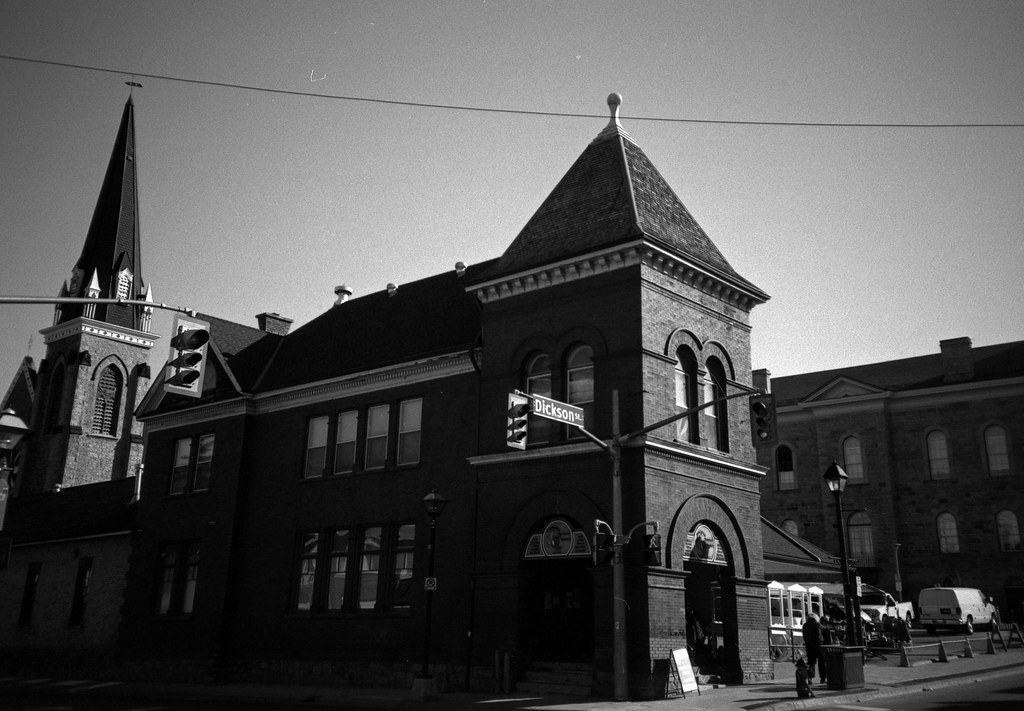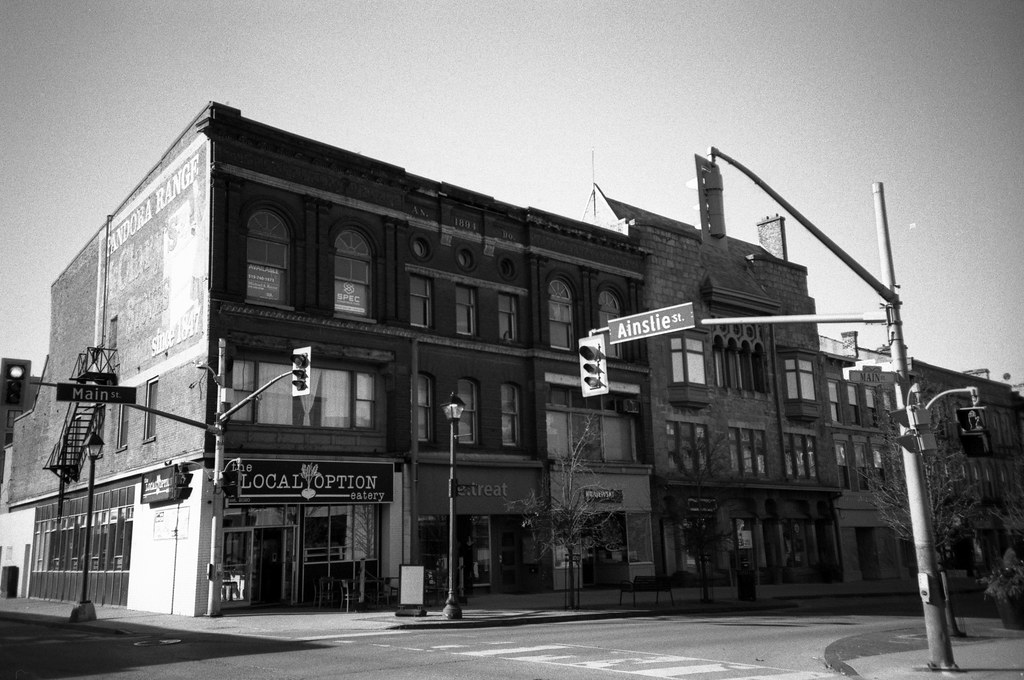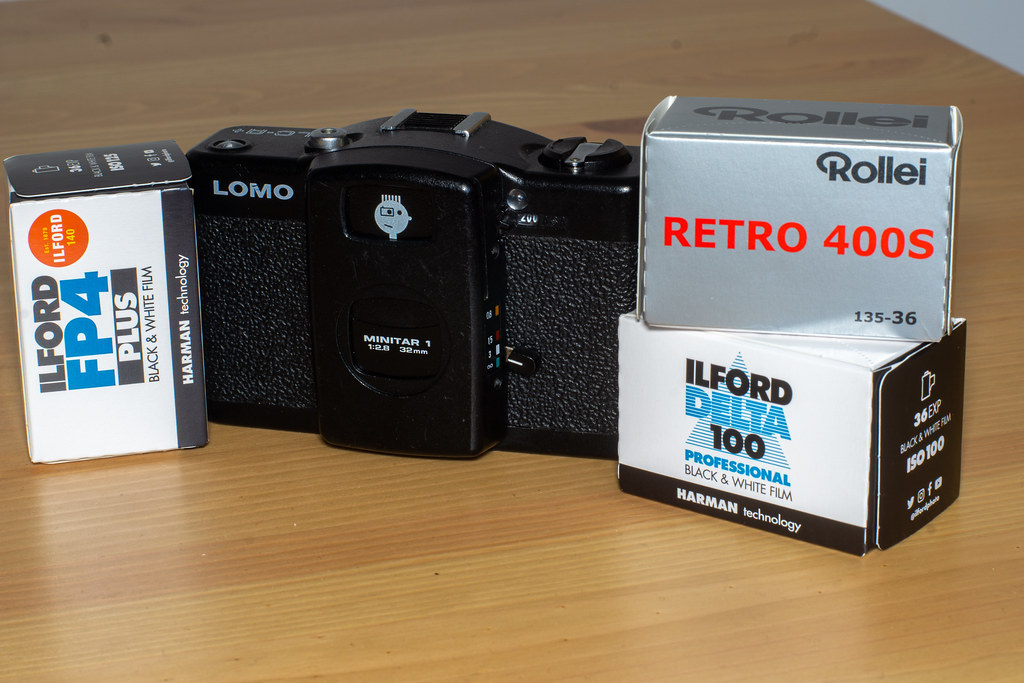Suppose a singular camera relaunched the love of film photography and sparked the inspiration of hundreds if not thousands of photographers. That camera is the LOMO LC-A. While this particular camera is not an LC-A, it is, in the proper fashion of the original LC-A, a direct successor and continuation on the inspiration given by that fateful day in 1991, but more on that later. The LC-A+ is Lomography’s answer to providing the classic look that gave the latter days of the Soviet Bloc rich saturated colours and heavy contrast. First released in 2006 after the closure of the original LOMO production lines for the LC-A, the LC-A+ added many featured that Lomography photographers were seeking. And while I had no desire to spend money on a new LC-A+, when one turned up at my doorstep, I wasn’t going to say no.
Camera Specifications
Make: Phenix Optical Company for Lomography International
Model: LOMO LC-A+
Type: Point-And-Shoot
Format: 135 (35mm), 36x24mm
Lens: Fixed, Lomography Minitar-1 1:2.8 32mm (3 Elements in 3 Groups), f/2.8 – f/16
Shutter: Focal Plane Leaf Shutter, 1/500″ – Unlimited
Meter: 1x CdS Cell, EV2 ~ EV17 @ ASA-100, ASA-100 – ASA-1600
Year of Manufacture: 2005-Current
Background
The story of the LC-A+ does not start in Prague, Vienna, or even St. Petersburg; it starts in Nakano, Japan. In the early 1980s, Cosina released the CX-1 and, in quick succession, the CX-2. These cameras where compact zone-focus point-and-shoot cameras. Offering full Auto-Exposure and limited Aperture Priority AE control, when you picked an aperture, the camera defaulted to a shutter speed of 1/45″ designed for use with a flash. As the story goes, in 1981, a CX-1 or CX-2 ended up in the hands of General Igor Petrowitsch Kornitzky. Kornitzy, right-hand-man to the Minister for Industry and Defence in the USSR. General Kornitzky invited his good friend Michail Panfilowitsch Panfiloff to take a closer look at the camera. History is foggy, which CX ended up on the General’s desk. Both men enamoured with the camera, the rugged metal construction, the five-element 35mm f/2.8 lens, and Auto-Exposure controls. It was like nothing the Soviet camera industry had seen. Panfilov, being the director of the ЛОМО (LOMO), Ленинградское Оптико Мечаничесцкое Обйединение (Leningrad Optico Mechanical Association), turned to his top engineer to design a Soviet version of the CX-2. Mikhail Grigorievich Kholomyanski began to design the new camera, but rather than make a direct copy which might anger the Japanese camera maker Cosina. He made plenty of changes to the design. Kholomyanski turned to Mr Tarabukin to make a copy of the 35mm f/2.8 lens. The goal set out by General Kornitzky, and Director Panfiloff was to create a camera for the masses that allowed full AE and a brilliant optical experience. The new camera would not be the first attempt by LOMO to design an auto-exposure camera. They had several prototypes through the 1970s, but the guts of the CX-2 marked a major leap forward for the Soviet camera industry. The prototype arrived later in 1981 and did not meet Kornitzky’s criteria. The design too far removed from the CX-2 and the Tarabukin lens would increase the camera’s overall cost and make it out of the range of most citizens. The USSR did not need a camera for the export market, the camera, now called the ЛОМО Компакт Автомат (LOMO Compact Automatic, or Kompact Automat), would be strictly for the domestic market or out to the wider Soviet Bloc. Kholomyanski, shaken by the General’s anger, returned to his drawing board and, hoping to avoid a one-way trip to a Siberian Gulag, designed a camera far closer to the CX-2 just different enough to avoid infringement of the Cosina Design. He also handed the lens design over to Lev Sakin, who produced a triplet design lens for the Kompact Automat, calling the 32mm f/2.8 lens the Minitar 1. The second prototype arrived in 1982 and met with some success in a test market of St. Petersburg, as LOMO prepared to move into mass production of the Kompact Automat. To ensure success, they had built a second version of the camera, calling it the Смена-18, a near copy of the Kompact Automat but offered up a fully mechanical camera. Both the Смена-18 and Смена-19 were presented to General Kornitzky for his final approval and green-light to being mass-produced. Now please, the general gave the nod to both the Смена 18 and 19. And mass production started in 1984. And while LOMO did produce the Смена-19 a replacement to the Смена Символ (Smena Symbol), itself an improvement on the Смена 8m, with a selenium meter akin to the Olympus Trip 35, production lasted from 1985-9 and only in a limited fashion. the Смена-18 was shoved in a safe and never spoken of again. Instead, the St. Petersburg LOMO plant began pumping out the Kompact Automat in 1984 at a rate of 1,000 units per month. LOMO employed some 1,200 workers on the Kompact Automat assembly line, 500 directly responsible for final assembly. A majority of these workers were young women who’s fine motor control helped with the small design. The camera proved an overnight success and quickly moved out into the Soviet Bloc, with some of the popular spots being Cuba, Vietnam, the German Democratic Republic (East Germany), Poland, Ukraine, and Czechoslovakia. LOMO even produced a limited number branded as the Zenith Lomo found their way west of the Iron Curtain. Little did LOMO know that their little camera would capture the final years of Soviet Russia. Even still in 1986, LOMO produced a special version for the 27th Anniversary of the Communist Party. The same year they produced an improved version, the LK-M with a better shutter and a standard threaded cable release, but few were ever produced. The fall of the Berlin Wall in 1989 marked the beginning of the end after a series of revolutions throughout the Soviet Bloc began to see a flood of western cameras that were far superior to many produced in the east. By 1991 even the USSR fell, and sales of the LC-A tanked. Just as many East wanted cameras from the West, many Western travellers were taking advantage of the newly opened borders. One group of students from Vienna found themselves in a Prague junk shop in the newly christened Czech Republic. Among the many wares, they found a Kompact Automat, or LC-A as they were called. Buying the camera that they had never seen before, they quickly fell for the vignetted optics, rich saturation and deep contrast. Not to mention the simplicity of the operation. When they returned to Vienna, they took several more LC-A cameras with them and in 1992 founded the Lomographic Society International, or simply Lomography. Using the LC-A as their flagship, they promoted a new photography style, one based on gut instinct and less than perfect cameras. They got their hands on as many LC-As as they could and began to fix, refurbish, and sell the cameras. Despite the second wave, by 1994, LOMO had closed up the LC-A production line. Lomography had plenty of cameras to choose from, but even these were becoming scarce, hard to find and rising in price as demand increased. Rather than face the loss of their flagship, they travelled to St. Petersburg. After several rounds of negotiations with LOMO and the city’s mayor, one Vladimir Putin (yes, that Putin), they struck on a new deal to restart production of an improved LC-A. The 1997 version of the LC-A remained mostly unchanged from the original version but featured a standard threaded shutter release, ASA markings instead of GOST, and an improved shutter. LOMO ramped up production of the new LC-A to near Soviet-era levels, and Lomography happily sold the camera into the hands of waiting photographers. But by 2005, LOMO faced two problems. The first being that many of their workforce on the LC-A line had been part of the original run and were starting to age or die, plus LOMO could no longer afford to keep such a niche product in a high-tech world. And in 2005, it officially ended the LC-A. But truly like the original LC-A, Lomography reinvented their original camera and licensed production to Phenix Optical in China. The new LC-A+ took many of the improvements made to the 1997 version of the LC-A, such as a threaded shutter release, ASA scale, and improved shutter reliability. A few grams of weight was shaved by switching the camera body to plastic rather than metal. A set of groves allowed for different lens accessories, removable door allowed for a Fuji Instax Mini back. And the Chinese copy of the Minitar 1 a near-perfect copy of the original LOMO lens, although Lomography did have a limited release of LC-A+ RL that had an original LOMO lens mounted. But Lomography did not stop there; they also released the LC-W with a wide-angle lens and the LC-A+ 120, a medium format version of the camera shooting a 6×6 image.


Impressions
If you’re not used to Lomography cameras, you might be a little concerned at how plastic the camera feels, it’s light, and it feels like you might break it by looking at it wrong. And while the camera does have its weak spots, and you do have to be a little careful with it, it is of decent construction. In true Soviet form, the original LC-A was of all-metal construction, but the new LC-A+ is almost all plastic, some metal bits, but it is mainly plastic. But all this and small design makes the camera insanely practical as a pocket camera that you can carry around everywhere without any weight considerations. Control-wise, there is little that you need to worry about on the camera; the two main items are marked and in an excellent spot for how you hold the camera. The focus leaver, which allows you to focus from infinity to 0.8m, is located on the left and controlled by your index finger. Second, the shutter release is located in a comfortable spot for your index finger. The film advance is a dial-type but has rounded knurls, so it doesn’t dig into your fingers in cold weather. The film speed control is awkward to operate, being hidden in a nook with a gear-like dial. You do have speeds between 100 and 1600 which isn’t too bad, but you do not have any slow speeds. One note is that the actual meter sensor is not TTL, there’s a small dome above the film speed indicator. Make sure you don’t cover that with your hands when out, or your camera’s meter reading is thrown out of whack. The on/off switch is under the front lens housing, the multi-exposure button, and the battery compartment. While there’s no hardware for a neck strap, a wrist strap is present and is helpful.


Experiences
If there’s one thing that I can generally describe, my experience with the LC-A+ is fun. Yes, despite any flaws or, as we say in the IT world, ‘features’ the LC-A+ is an enjoyable camera to use. And I can honestly see why it became super popular both in the original run and today in the Lomography circles. The camera is small and lightweight and adds nothing to any camera kit, and can be carried in a pocket. Loading the camera is easy, with the back being released by the spring release by pulling up the rewind knob. Here’s one of the camera’s weak spots; as soon as you pull up the rewind knob, you’ll feel a structural weakness. While mine has not broken, I’m also careful. Loading the film is straightforward, advancing and clicking advance and click motion until you get to the ‘1’ on the film counter. While compact, the camera fits well in hand, and the only real trouble I see is blocking off the exposure sensor. The shutter release is big, and there’s a satisfying click when the shutter is triggered. The viewfinder is big and bright but offers zero feedback or help in correcting for parallax. But if you’re shooting an LC-A+, there’s a chance that you don’t care too much, but the viewfinder is close to what the lens sees. The only feedback that you get is a single red LED that lights up to indicate that there is enough charge in the battery to operate the camera. Once there, just point-and-shoot to your heart’s content. The camera also has a hot shoe, but you’re want to use a smaller flash not to throw off the camera’s balance. Rewinding the film is triggered by a release button on the bottom of the camera, and there’s enough clearance to use the rewind knob without adjusting its height. Despite the simplicity, the camera is a joy to use, even for me given that I’m used to feature-rich cameras with tonnes of feedback and details in the viewfinder, joy in simplicity. Of course, the camera is far from perfect. You will face spacing issues, and missed exposures in strange lighting conditions, and your own hand blocking that metering eye.


Optics
Next to the LC-A’s auto-exposure functionality, the next most significant draw to this camera is the lens. As I mentioned in the camera history, the original Cosina camera had a far more complex lens. Still, the Soviet optics designers created a three-element lens that produces a sharp image. This Minitar lens is a gem among Soviet camera designs, and while the LC-A+ that I had does not have an original Russian lens. If you have a Lomography produced LC-A made 2005-7, the lens is an original one, built at the LOMO factory under contract, with original parts (and in some cases workers). When production shifted to China from 2007 onwards, the lens is made to the same specifications by their Chinese factory. Of course, you can still get a Russian made lens marked with an RL designator, but you will pay an extra premium. The lens produces a unique image that is almost tied to those early days of Lomography and the last days of the Soviet Bloc, rich saturated photos and plenty of contrast. The lens has a decent sharpness for a three-element lens but does have plenty of vignetting at the corners when wide open.


Lowdown
While it will never be a primary camera for me, well, it might for special days like International Communist Camera Day or World Toy Camera Day, I certainly can see it coming along on trips, photo walks, and just being in the pocket or bag if I need a quick run and gun. While I only have shot black & white film through the camera, I certainly plan on trying out more colour film to see that rich deep saturation that the Minitar-1 renders. If you are looking for one of these, it’s going to be buyer beware. There is still plenty of original LC-As floating around, and you can get some for under 100$ on the used market. Honestly, unless it were new-old stock in the original sealed box, I wouldn’t pay more than 100$. Most are averaging 40-70$ on the used market. If you are looking for one, target sellers from the former Bloc countries, Ukraine, which was a famous market for the LC-A, even the Czech Republic and Russia. But remember, the cameras are starting to get old and not many people can fix them. Plus, the original models are known for dodgy shutters. You can still buy an LC-A+ new direct from Lomography, and as I’ve said in this review, they are excellent, fun, and worth some money. New LC-A+ cameras will cost you a fair nickel. You’re looking at 350$ for the basic model. The Wide-Angle version is around 500$, and the Medium Format LC-A is 600$. They are a little cheaper on the used market, but there aren’t many on the market (no surprise there), but I did see the ones in the 130-250$ range. In this case, buy new to ensure a good working model and support the fine folks at Lomography. The LC-A is the camera for the masses, simple, easy to use, and designed, like all Soviet-era cameras, to bring photography to the masses. It did so, twice, not bad for a Soviet copy of a Japanese camera that seems to have overshadowed its original.
Further Reading
Don’t just take my word on the LC-A+, you can check out the reviews by other awesome camera reviewers!
Kosmo Foto – Lomo LC-A+ Review
35mmc – Lomo LC-A+ Review – love it or hate it…. or both?
Lomography.com – Lomo LC-A+ : Review as a LC-A+ newbie
Looking for reviews of the OG camera check out these excellent LOMO LC-A Reviews!
Kosmo Foto – Lomo LC-A review
James Cockcroft – The Lomo LC-A: A Review
Ryan Shockey Davis – Lomo LC-A Review: Comprehension of the Necessities
Film Shooters Collective – Lomo LC-A Review
Film Wasters – Looking past the Hype – an honest review of the LOMO LC-A


Great review!
According to Lomo’s website, the current Lomo LC-A+ has been improved and mounts the original Minitar-1 lens.